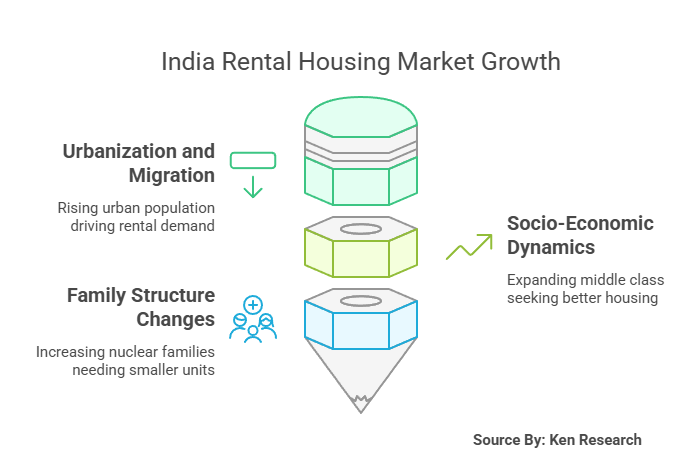The $20.29 Billion India Rental Housing Market Growth & Competitive Landscape

Strong 8k brings an ultra-HD IPTV experience to your living room and your pocket.
The India Rental Housing Market, valued at USD 20.29 billion, has witnessed significant growth due to urbanization, population migration to metropolitan cities, and the increasing prevalence of nuclear families. Government initiatives like the Pradhan Mantri Awas Yojana (PMAY) and the Model Tenancy Act have played a key role in formalizing the rental housing market, making it a viable investment opportunity for developers and a reliable option for tenants.
Growth Drivers of the India Rental Housing Market
- Urbanization and Migration: With 486 million people, or 36.36% of India’s population, living in urban areas by 2023, migration to cities like Mumbai and Bangalore continues to rise. Urban centers remain the epicenters for job opportunities, education, and lifestyle advancements, driving demand for rental housing.
- Changing Socio-Economic Dynamics: The projected growth of India’s middle class from 432 million in 2020-21 to over 1 billion by 2047 is creating demand for better rental housing. This is particularly evident in cities with thriving job markets like Pune, Hyderabad, and Gurgaon.
- Shift to Nuclear Families: The increasing trend of nuclear families in urban areas has led to greater demand for smaller, individual rental units. Cities like Hyderabad and Pune have witnessed a notable increase in such rental needs.
Explore the full report on India Rental Housing Market Research Report by Ken Research.
Top Cities Driving the Market
Major cities such as Mumbai, Delhi, and Bengaluru dominate India rental housing market, and here’s why:
- Mumbai: Known as the financial capital of India, Mumbai attracts millions of professionals every year, creating a consistent demand for rental housing. The city's housing options cater to various income levels, from affordable rentals in suburbs to luxury accommodations in prime locations.
- Delhi: As the national capital and a key commercial hub, Delhi attracts students, working professionals, and families. The high density of educational institutions and corporate offices drives rental demand in areas like South Delhi, Noida, and Gurgaon.
- Bengaluru: Popularly referred to as India’s Silicon Valley, Bengaluru sees massive demand for rental housing due to its thriving IT and startup ecosystem. The influx of young professionals has also led to a growing trend of co-living spaces in the city.
These cities offer diverse rental options, making them hotspots for migration and economic activity.
Top Players Transforming the India Rental Housing Industry
Several companies have redefined the rental housing ecosystem in India by leveraging technology and innovation.
- Oyo Life: A leading player offering fully-furnished rental accommodations with flexible agreements, popular among young professionals and students.
- NestAway: Known for tech-driven rental solutions, it provides easy property listing, agreements, and tenant management on its digital platform.
- Stanza Living: A leader in the co-living space, focusing on creating community-centric rental housing tailored for millennials.
- Zolo Stays: With a strong presence in metros, Zolo Stays is revolutionizing shared living with tech-enabled solutions.
- NoBroker: A platform that eliminates intermediaries in property renting, offering tenants and landlords a direct and seamless experience.
Future Outlook
The India Rental Housing Market is poised for steady growth in the coming years. Factors such as urban migration, tech-driven rental solutions, and government incentives will continue to drive demand.
- Co-living Spaces: With the rise of millennial renters, co-living spaces are set to gain more traction. These affordable, community-driven housing options will dominate cities with high inflows of young professionals.
- Expansion into Tier 2 & 3 Cities: Cities like Jaipur, Surat, and Coimbatore will emerge as rental hubs, driven by improved infrastructure, lower costs, and growing job opportunities.
Conclusion
The India Rental Housing Market is undergoing a transformation, supported by urbanization, changing family structures, and government policies. While challenges such as high rental costs and regulatory barriers remain, innovations in co-living spaces and the shift to Tier 2 and Tier 3 cities present significant growth opportunities. With increasing investments and the integration of technology, the market is set to evolve into a more organized, transparent, and tenant-friendly ecosystem.
Note: IndiBlogHub features both user-submitted and editorial content. We do not verify third-party contributions. Read our Disclaimer and Privacy Policyfor details.







